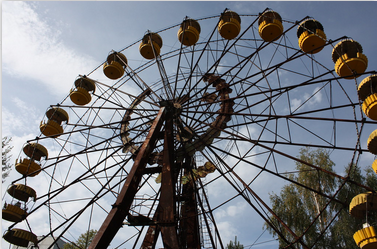Introduction
Children were the silent victims who suffered the most from the 1986 Chornobyl catastrophe, caused by a multitude of systematic failures. Their pain has often been overlooked when assessing the devastation triggered by Chornobyl. Their bodies were much weaker than adults, and much more susceptible to death and debilitating illnesses. The generation succeeding Chornobyl was born with genetic mutations caused by the radiation that spread across the vicinity of Kyiv. The Soviet government overlooked the harm and loss that these children endured in an attempt to minimize the severity and lasting impact of this disaster––an effort to escape some of the blame and failure placed on them. The government’s refusal to acknowledge or address the full extent of damage caused by this disaster was unjust and a perversion of the responsibility they had to uphold to their citizens. The government’s inaction exacerbated the damaging effects the disaster had on all people which could have been avoided or at least understood if it wasn’t for their lack of transparency when sharing information about the effects of the Chornobyl reactor meltdown with their citizens.
Many men and women suffered from the radiation that spread after the reactor’s failure, and there are plenty of sources that discuss their loss. But what about the children? The kids who died months after the meltdown, tortured by the fear of some unknown disease that the government refused to share information about. Or how how the government fooled its people with its silence and let them volunteer to “pick cucumbers and tomatoes—and leaves [that] would have these black holes” without knowing the full extent of harm radiation could cause to their health (Alexievich 50). The government never told the people how that radiation can spread and contaminate everything, and how a father giving his son his baseball cap would leave “him [with] a diagnosis: a tumor in his brain” (Alexievich 50). The soldier who shared his experience in Svetlana Alexievich’s Voices from Chernobyl could have prevented his son’s tumor, but he was never warned of the dangers that could potentially stem from simply working in a garden. His grief is real, his child is gone, and his government betrayed him by not giving him the tools and information to prevent it. The choices he made unleashed a chain of events that led to his unknowing role in his son’s death. Many other parents experienced the same thing with their children in the aftermath of this disaster. Alexievich shares another story, and talks about how children “had black spots all over their bodies” and that “these spots would appear, then disappear” (Alexievich 18). These were visible marks of serious radiation poisoning, and yet when the father asked the doctor what the spots on his daughter was, she responded that “It’s not for you,” (Alexievich 18). “They” being the government, chose to not share information. They chose to keep information about the devastating impact of their mistakes secret, to ensure that their constituents weren’t able to understand what was happening to them, and it’s unforgivable. Attempting to keep the medical information of one’s child was an attempt to silence the families of victims, to force them to forget the root cause of their loss and simply concede to the government. But it never worked, because even when they say ignorance is bliss, one cannot be ignorant after seeing “seven little girls shaved bald in one room” from illness or watching their daughter pass away; they “put [her] on the door…on the door that my father lay on. Until they brought a little coffin. It was small, like the box for a large doll” (Alexievich 18). The loss of adolescent lives, as well as the fear and suffering they must’ve endured in their short time, is unspeakable, especially because circumstances would have been extremely different if the government wasn’t trying to suppress information rather than share it. Despite this, what the Soviet Union failed to recognize at the time was that no matter how much they tried to lie and neglect the impact of radiation across their border, they could never fool the people who were experiencing it firsthand.
When something disastrous happens, one reasonably expects the government to take immediate acknowledgement of said disaster, before proceeding to address methods of controlling and reacting to that awful situation. However, that wasn’t the case in the Soviet Union when the Chornobyl disaster happened. The first response the Soviet government had was nothing—just silence. Bonnie Poulsen’s article “But What of the Children of Chernobyl” mentions how the government took “almost two weeks after the accident [to tell] the citizens of Kyiv that there had been a meltdown of the nuclear reactor at Chernobyl” (Poulsen 68). Two weeks in the face of lethal and poisonous radiation can make all the difference between life and death, so for the government to withhold such vital information from citizens who were so close to the reactor when the meltdown happened is completely out of line, and a violation of the citizens’ trust. It feels as if the government didn’t even see civilians as people because they took no real or substantial measures to save their people when it truly mattered. It was only after the two initial weeks of the meltdown that the city was cleaned. Soon, a city filled with life became “such a quiet city - [with] no children,” because there was none left (Poulsen 68). Cleaning a city and acting as if they care about it after letting its population unknowingly get contaminated by radiation was a feeble attempt by the Soviet government to save face and demonstrate their efforts to help people. If the Soviet government wanted to show to their country and the world that they cared about their citizens, they wouldn’t have refused to acknowledge the extent of the damages they caused. One institution the government refused to accept was the Hematology Center for Children, which explained why the children’s hospital was described to be “barren with peeling paint, and had an odor suggesting age, inattention or neglect” (Poulsen 68). The government’s refusal to divert funds to the hospital’s goals was intentional to salvage its reputation. If they had operated under a moral compass and funded the hospital’s noble cause, they would have had “to concede there were more and lingering casualties associated with the accident and its radioactive fallout than the government would publicly acknowledge” (Poulsen 68). Funding efforts to help treat children with cancer is an admission of guilt by the Soviet government which is something they couldn’t afford to do because of the scrutiny they were under. This does not erase the fact that children are some of the most unrecognized casualties caused by not just the radiation from Chornobyl, but of governmental failure and mistreatment––they deserved better, and avoiding and neglecting these children doesn’t cease their existence. The government’s refusal to acknowledge all of the damage they caused doesn’t end there though, and the numbers and research don’t lie. A study published in the Journal of Child Psychology and Psychiatry by Vladimir Drozdovitch, Sergey Igumnov, and Y.L. Kolominsky compared children who suffered prenatal radiation exposure to children of similar ages from an uncontaminated area in Belarus. After a series of tests, it was determined that the “exposed group manifested a relative increase in psychological impairment compared with the control group, with increased prevalence in cases of specific developmental speech-language disorders ” (Kolominsky Igumnov Sergey 299). The data provided by this article show a steep difference in the IQs of children in the exposed group vs. the control and can be read on the recreated door pictured on this page. Kolominsky, Igumnov, and Sergey were not the only researchers whose findings have pointed toward differences in the brains of children exposed to Chornobyl radiation in utero. Another study mentioned in Kolominsky, Igumnov, and Sergey’s report focused on the development of children from Chornobyl-affected regions revealed an “increase in microcephaly, Down’s syndrome, or congenital defects of the central nervous system at age 2 to 3 years. At the same time, investigators noticed borderline retardation of psychomotor and speech development,” ultimately proving that the conclusions that the three researchers arrived at are similar to others in the field researching mental impacts of Chornobyl radiation exposure (Kolominsky Igumnov Sergey 300). Data such as this cannot be taken lightly and corroborates how the effects of Chornobyl extend through generations and is something that has changed the lives of an innumerable amount of people. The government cannot deny these discrepancies because there is a pattern in these findings that verifies the government lied about the extent to which Chornobyl impacted its citizens.
I can believe that the Soviet Union tried to respond to the Chornobyl disaster to the best of its ability, but that wasn’t enough and doesn’t negate the fact that they did a great injustice to their citizens. Their half-hearted measures for better optics, unfortunately, came at the cost of innocent children’s lives. The government failed in its duties as a governing body that was supposed to protect the nation. They were silent and inactive, until they lied, misled, and withheld life-altering information from the people affected most, all in an attempt to do some damage control––which was an irreversible mistake that caused the suffering of too many people and too many children.

Bibliography
-
Alexievich, Svetlana. Voices from Chernobyl. Translated by Keith Gessen, St Martin’s Press, 2006.
-
Development of Children from Belarus Exposed in the Prenatal Period to Radiation from the Chernobyl Atomic Power Plant.” Journal of child psychology and psychiatry, and allied disciplines. 40. 299-305. 10.1111/1469-7610.00444.
-
Kolominsky, Y & Igumnov, Sergey & Drozdovitch, Vladimir. (1999). “The Psychological
-
Poulsen, Bonnie L. “But What of the Children of Chernobyl?” Journal of Environmental Health, vol. 54, no. 6, 1992, pp. 68–69. JSTOR, http://www.jstor.org/stable/44534061. Accessed 8 Nov.
Rezwana (‘26) is from NJ and plans to be a neuroscience major.
RUSSB220 Chornobyl, Bryn Mawr College, Fall 2023
Licensed under CC BY-NC-SA 4.0.



